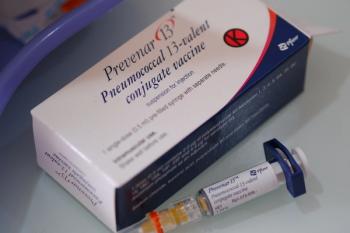
Self-care for Upper Respiratory Tract Infections
Pharmacists can offer OTC recommendations for symptom relief.
Pharmacists are an excellent resource for patients to ask questions about upper respiratory infections, especially with the ongoing COVID-19 pandemic. As trusted and accessible health care professionals, they can effectively counsel patients on appropriate OTC products and refer them to their physician when necessary.1
The upper respiratory system consists of1:
- Nose/nostrils
- Nasal cavity
- Mouth
- Throat (pharynx)
- Voice box (larynx)
Most upper respiratory infections are caused by a virus and include the common cold, sinusitis, pharyngitis, epiglottitis, and laryngotracheitis (see Table).2
Sinusitis
Sinusitis is an acute inflammation of the paranasal sinuses and can be caused by viruses or bacteria.2 Symptoms include pain, pressure, and tenderness around the sinus, as well as nasal discharge. Patients may feel tired and have a slight fever. Symptomatic treatment with analgesics and moist heat, as well as a decongestant, can be helpful. If an antibiotic is needed, amoxicillin/clavulanic acid is a first- line treatment.
Pharyngitis
Pharyngitis is an inflammation of the pharynx (throat), which can be caused by bacteria, virus, or fungus, or by smoking.2 Most cases are viral and occur with a common cold or flu. Symptoms include a red, sore, or “scratchy” throat. Fever, fatigue, muscle pain, or headache may occur, as well as swollen lymph nodes and difficulty swallowing. Treatment is symptomatic unless the virus is caused by herpes simplex, in which case acyclovir is used. If an antibiotic is needed, a penicillin or macrolide is often used.
Common Cold
The common cold is the most prevalent type of respiratory infection.2 Usually caused by a virus, its symptoms include a stuffy or runny nose, sneezing, sore throat, and cough. Fever rarely occurs, and complications are rare. Sometimes, sinusitis or an ear infection may develop. Treatment for a common cold is symptomatic. caused by bacteria, virus, or fungus, or by smoking.2 Most cases are viral and occur with a common cold or flu. Symptoms include a red, sore, or “scratchy” throat. Fever, fatigue, muscle pain, or headache may occur, as well as swollen lymph nodes and difficulty swallowing. Treatment is symptomatic unless the virus is caused by herpes simplex, in which case acyclovir is used. If an antibiotic is needed, a penicillin or macrolide is often used.
Epiglottitis and Laryngotracheitis
Epiglottitis or laryngotracheitis (croup) is an inflammation of the upper airway. The diagnosis depends on location, symptoms, and pathogens.2 Epiglottitis, most often caused by Haemophilus influenzae type b, is less common in adults and can be associated with viral or bacterial infections. Laryngotracheitis is usually viral. Epiglottitis symptoms begin with sudden onset of fever, sore throat (“cherry-red” epiglottis), hoarseness, drooling, and difficulty swallowing. It can quickly progress to severe respiratory distress and can be fatal. Epiglottis is a medical emergency, especially in children, who need immediate emergency care including intubation and antibiotics (against H influenzae).
Symptoms of laryngotracheitis (croup) include a runny nose, fever, sore throat, and mild cough, progressing to tachypnea, a barking cough, and stridor. Treatment includes observation, fluids, and humidified air. The H influenzae type b conjugate vaccine (and immunization against diphtheria) is recommended in all children for prevention.
Other Common Infections
Lower respiratory infections include bronchitis, bronchiolitis, and pneumonia. They are often bacterial in nature, requiring antibiotics in such cases.2
Otitis media, or middle ear infection, is another common infection, especially in children. It may be bacterial or viral and should be referred to the pediatrician or internist.
OTC and Self-Care Recommendations
Morton Tavel, MD, is a clinical professor emeritus of medicine at Indiana University School of Medicine. Tavel reminds pharmacists that “despite the discomfort from the sneezing, sore throat, cough, and runny nose of a viral infection, happily, it gets better on its own without requiring any special treatment, usually within a week but sometimes a bit longer.”
Chris Schiller, PharmD, is the CEO of Economy Pharmacy, Inc, in Muskogee, Oklahoma. He recommends guaifenesin or guaifenesin-pseudoephedrine (Mucinex or Mucinex-D), depending on symptoms, as well as humidifiers and camphor eucalyptus oil-menthol (Vicks VapoRub).“My primary focus is on immune system health,” he said. He recommends supplements such as probiotics and immune support products, which combine vitamin D, vitamin C, zinc, and quercetin.
Tavel says pharmacists should dis- cuss other conditions the patient has that may not be compatible with a recommended OTC medication (for example, patients with hypertension should not use an oral decongestant).
Antibiotic Use
According to the CDC, at least 47 million unnecessary antibiotic prescriptions are issued every year in the United States, which can lead to adverse effects and antibiotic resistance.3 When counseling patients, pharmacists should remind them that antibiotics do not treat viral infections. “[Seeing] they have no effect on the culprit viruses, contrary to the almost universal misconception, antibiotics should not be employed,” Tavel said. “Using them will neither shorten the cold’s duration nor prevent its spread to others. Moreover, the more we take antibiotics, the greater chance of producing resistant bacteria that could create mischief to others at a later time.”
Instead, Tavel recommends that patients consult their physician if their cold lasts for over a week or causes a moist cough, or if a fever lasts for more than 2 days. Antibiotics are needed for certain bacterial infections, such as pneumonia or sepsis. They are also necessary for high-risk patients, such as those with severe kidney disease or who are undergoing chemotherapy.4
Patients should visit their internist if symptoms persist or are severe. The internist can perform an examination, order labs and cultures if warranted, and decide if an antibiotic is needed.
References
1.Upper respiratory tract. MedlinePlus. [KM1]Updated February 26, 2021. Accessed March 24, 2021.
2.Dasaraju PV, Liu C. Infections of the Respiratory System. In: Baron S, ed. Medical Microbiology. 4th ed. University of Texas Medical Branch at Galveston; 1996. Accessed xxx xxxx.[KM2]
3.Antibiotic prescribing and use. CDC. Updated November 13, 2020. Accessed March 24, 2021.
4.Be antibiotics aware: smart use, best care. CDC. Updated November 17, 2020. Accessed March 24, 2021.
5.Antibiotic do’s & don’ts. CDC. Updated January 31, 2020. Accessed March 24, 2021.
Newsletter
Pharmacy practice is always changing. Stay ahead of the curve with the Drug Topics newsletter and get the latest drug information, industry trends, and patient care tips.


















































































































